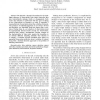112
click to vote
UAI
1998
15 years 2 months ago
1998
The process of diagnosis involves learning about the state of a system from various observations of symptoms or findings about the system. Sophisticated Bayesian (and other) algor...
116
click to vote
ICCS
2007
Springer
15 years 2 months ago
2007
Springer
Abstract. Humanity’s understanding of the Earth’s weather and climate depends critically on accurate forecasting and state-estimation technology. It is not clear how to build a...
AINA
2010
IEEE
15 years 5 months ago
2010
IEEE
Abstract—We describe a Bayesian formalism for the intelligent selection of observations from sensor networks that may intermittently undergo faults or changepoints. Such active d...
106
Voted
AIIA
2005
Springer
15 years 6 months ago
2005
Springer
Abstract. When dealing with real systems, it is unrealistic to suppose that observations can be totally ordered according to their emission dates. The partially ordered observation...
122
Voted
IJCNN
2006
IEEE
15 years 6 months ago
2006
IEEE
— Adaptive filtering is normally utilized to estimate system states or outputs from continuous valued observations, and it is of limited use when the observations are discrete e...
100
click to vote
LOCA
2007
Springer
15 years 7 months ago
2007
Springer
Abstract. People rapidly learn the capabilities of a new location, without observing every service and product. Instead they map a few observations to familiar clusters of capabili...
ACIVS
2007
Springer
15 years 7 months ago
2007
Springer
This paper presents a new method to both track and segment objects in videos. It includes predictions and observations inside an energy function that is minimized with graph cuts. ...



